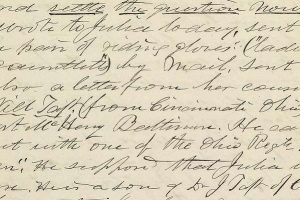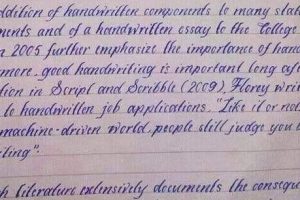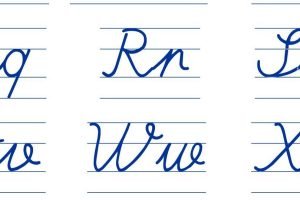The Ultimate Guide to Mastering the Cursive Writing Alphabet
Cursive writing is a timeless art that has been taught in schools for generations. It is a form of handwriting that is written in a flowing, connected manner. Learning the cursive writing alphabet can be a rewarding experience and can help improve your handwriting overall. In this guide, we will cover everything you need to know to master the cursive writing alphabet.
The Benefits of Learning the Cursive Writing Alphabet
Learning the cursive writing alphabet offers several benefits, including:
Better Handwriting: Cursive writing is a fluid and connected style of writing that can improve the legibility and overall appearance of your handwriting.
Enhanced Motor Skills: Learning cursive writing requires more fine motor skills than printing or typing. Practicing cursive writing can help develop and strengthen hand muscles and hand-eye coordination.
Improved Memory Retention: Research has shown that writing in cursive can help with memory retention and recall.
Understanding the Basic Strokes
Upstroke, Downstroke, and Loop: The cursive writing alphabet is made up of a series of basic strokes. These include the upstroke, which moves upwards from the baseline, the downstroke, which moves downwards from the baseline, and the loop, which is a curved stroke that connects two letters.
Practicing the Basic Strokes
Practice Sheets: The best way to improve your cursive writing skills is to practice the basic strokes. You can find practice sheets online or create your own by printing out lined paper and tracing over the strokes.
Posture and Grip: Your posture and grip are also important when it comes to cursive writing. Sit up straight and hold the pen or pencil in a relaxed grip that allows for fluid movement.
Learning the Cursive Writing Alphabet
Lowercase Letters: Start by learning the lowercase letters of the cursive writing alphabet. These letters are typically easier to write than the uppercase letters and provide a good foundation for building your cursive writing skills.
Uppercase Letters: Once you feel comfortable with the lowercase letters, move on to the uppercase letters. These letters are often more complex and require more precision, but with practice, you can master them.
To master the cursive writing alphabet, it is essential to first understand the basic strokes used to create each letter. The four main strokes used in cursive writing are:
Overcurve: A stroke that curves over the top and down to the right.
Undercurve: A stroke that curves under and back up to the right.
Upstroke: A straight stroke that goes from the bottom to the top.
Downstroke: A straight stroke that goes from the top to the bottom.
The Cursive Writing Alphabet
Now that we have covered the basic strokes of cursive writing, let’s dive into the cursive writing alphabet.
Uppercase Letters:
A: Overcurve, downstroke, undercurve
B: Upstroke, overcurve, downstroke, undercurve
C: Upstroke, overcurve, downstroke
D: Upstroke, overcurve, downstroke, undercurve
E: Upstroke, overcurve, downstroke
F: Upstroke, overcurve, downstroke, undercurve
G: Upstroke, overcurve, downstroke, undercurve, overcurve
H: Upstroke, downstroke, upstroke, undercurve
I: Upstroke, downstroke
J: Upstroke, overcurve, downstroke, undercurve
K: Upstroke, overcurve, downstroke, upstroke
L: Upstroke, downstroke, overcurve
M: Upstroke, overcurve, downstroke, upstroke, downstroke
N: Upstroke, overcurve, downstroke, undercurve, upstroke
O: Upstroke, overcurve, undercurve
P: Upstroke, overcurve, downstroke, undercurve, upstroke
Q: Upstroke, overcurve, downstroke, undercurve, upstroke, overcurve
R: Upstroke, overcurve, downstroke, undercurve, upstroke, downstroke
S: Upstroke, overcurve, undercurve
T: Upstroke, downstroke, overcurve
U: Upstroke, down stroke, undercurve
V: Upstroke, downstroke, upstroke, undercurve
W: Upstroke, downstroke, upstroke, downstroke, upstroke, undercurve
X: Upstroke, downstroke, upstroke, downstroke
Y: Upstroke, downstroke, upstroke, undercurve, downstroke
Z: Upstroke, overcurve, downstroke, undercurve
Lowercase Letters:
a: Upstroke, overcurve, downstroke, upstroke, undercurve
b: Upstroke, overcurve, downstroke, undercurve, upstroke
c: Upstroke, overcurve, downstroke
d: Upstroke, overcurve, downstroke, undercurve
e: Upstroke, overcurve, downstroke
f: Upstroke, overcurve, downstroke, undercurve
g: Upstroke, overcurve, downstroke, undercurve, overcurve
h: Upstroke, downstroke, upstroke, undercurve
i: Upstroke, downstroke
j: Upstroke, overcurve, downstroke, undercurve
k: Upstroke, overcurve, downstroke, upstroke
l: Upstroke, downstroke, overcurve
m: Upstroke, downstroke, upstroke, downstroke
n: Upstroke, overcurve, downstroke, undercurve, upstroke
o: Upstroke, overcurve, undercurve
p: Upstroke, overcurve, downstroke, undercurve, upstroke
q: Upstroke, overcurve, downstroke, undercurve, upstroke, overcurve
r: Upstroke, overcurve, downstroke, undercurve
s: Upstroke, overcurve, undercurve
t: Upstroke, downstroke, overcurve
u: Upstroke, downstroke, undercurve
v: Upstroke, downstroke, upstroke, undercurve
w: Upstroke, downstroke, upstroke, downstroke, upstroke, undercurve
x: Upstroke, downstroke, upstroke, downstroke
y: Upstroke, downstroke, upstroke, undercurve, downstroke
z: Upstroke, overcurve, downstroke, undercurve
As you can see, each letter has its unique combination of strokes that make up the cursive writing alphabet. Practice writing each letter slowly and carefully, paying attention to the movement of your hand and the formation of each stroke. With consistent practice, you will become more comfortable and confident in your cursive writing skills.
Remember, cursive writing may not be as widely used as it once was, but it still holds value in both personal and professional settings. So, take the time to master the cursive writing alphabet and enjoy the satisfaction of beautifully written words.
Troubleshooting Common Issues
Inconsistent Letter Size: One common issue with cursive writing is inconsistent letter size. To improve your letter size consistency, try slowing down and focusing on each individual letter.
Poor Letter Formation: Another common issue is poor letter formation. To improve your letter formation, try practicing each letter individually and paying close attention to the basic strokes.
Using Cursive Writing in Daily Life
Letter Writing: Cursive writing is often used in letter writing, as it adds a personal and formal touch to the communication.
Note Taking: Cursive writing can also be used for note-taking, as it is often faster than printing.
Artistic Applications: Cursive writing can also be used in artistic applications, such as calligraphy or creating decorative signs.
Conclusion
Mastering the cursive writing alphabet takes time and practice, but with patience and persistence, anyone can improve their cursive writing skills. Remember to start with the basic strokes, practice regularly, and pay attention to your posture and grip. With these tips and techniques, you’ll be writing in beautiful cursive in no time!









Add Comment